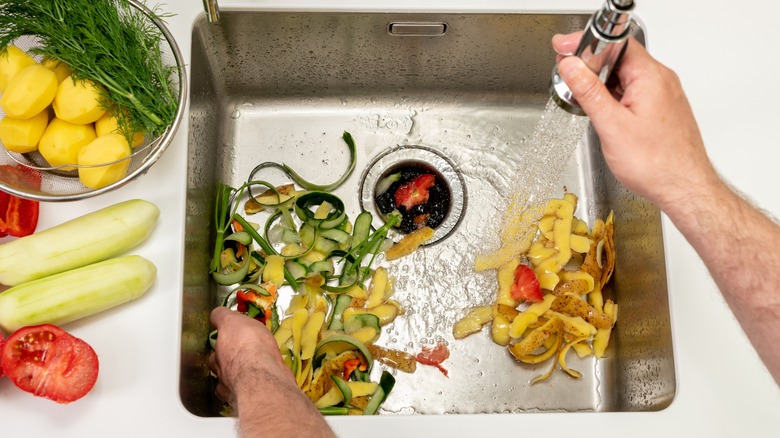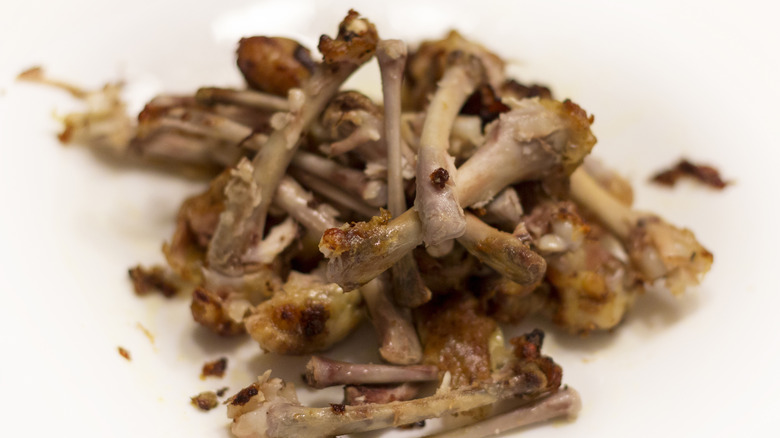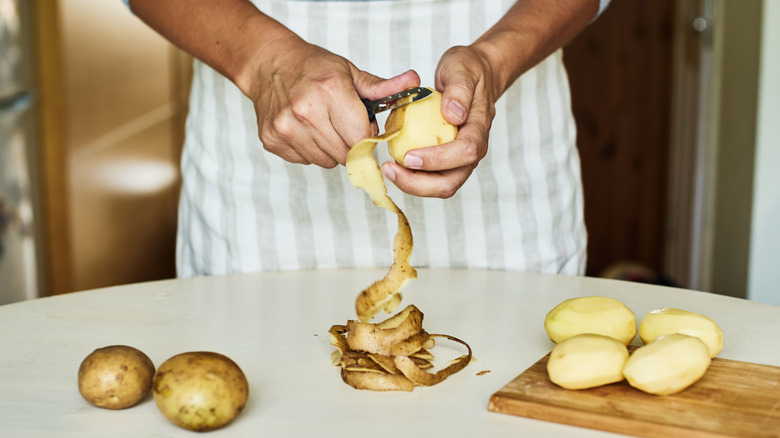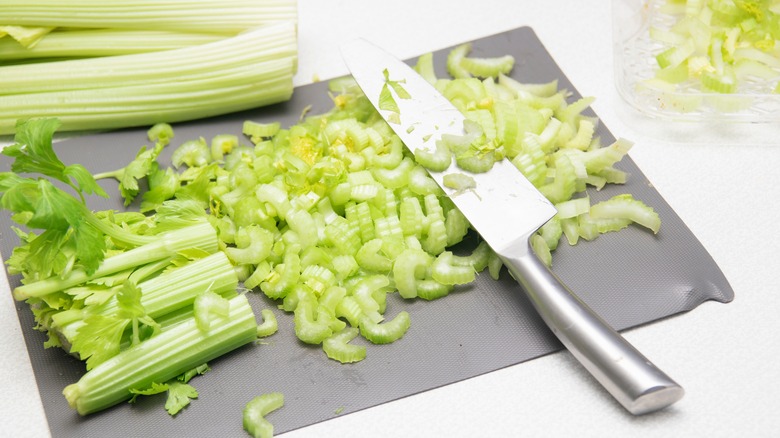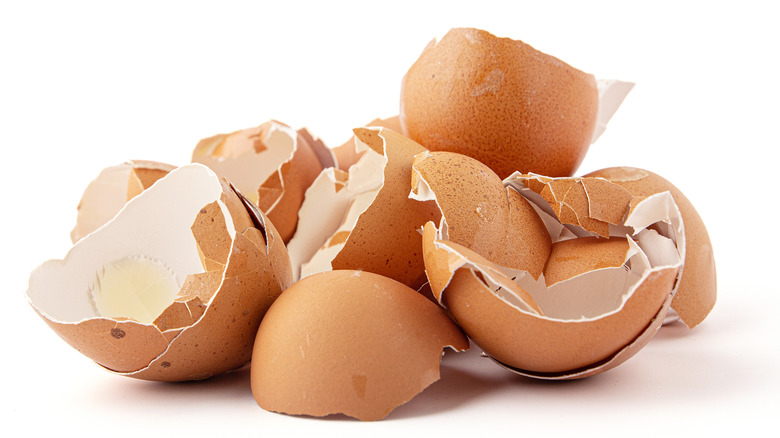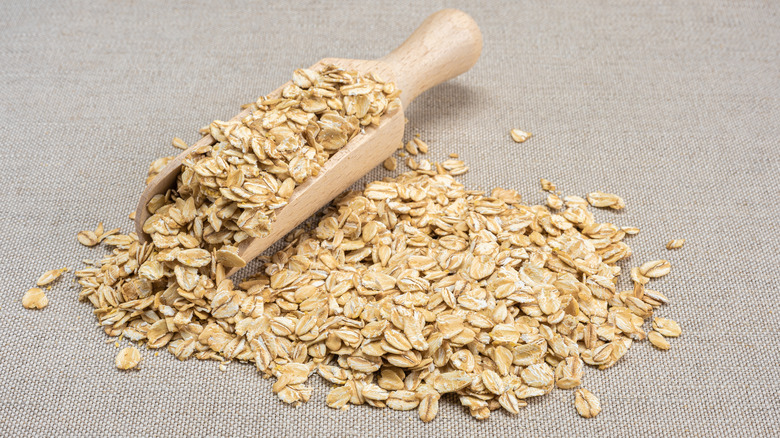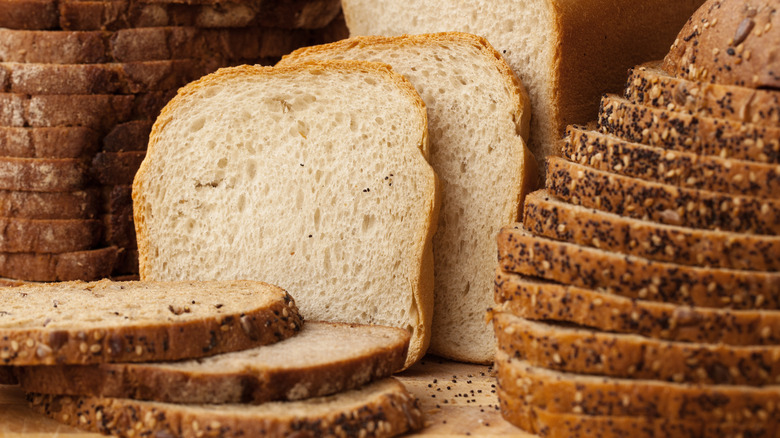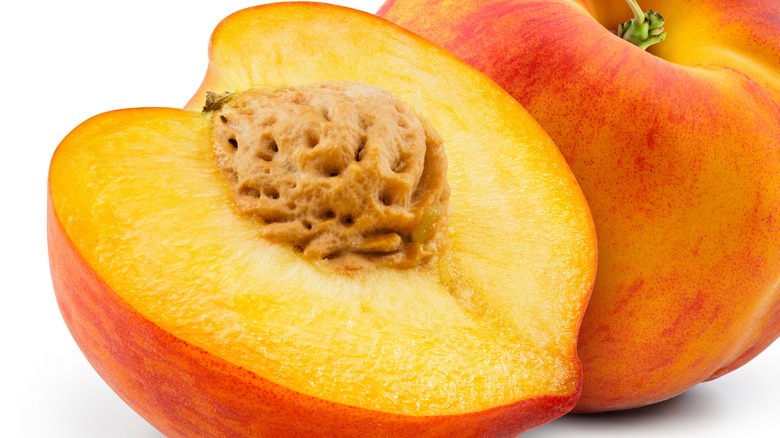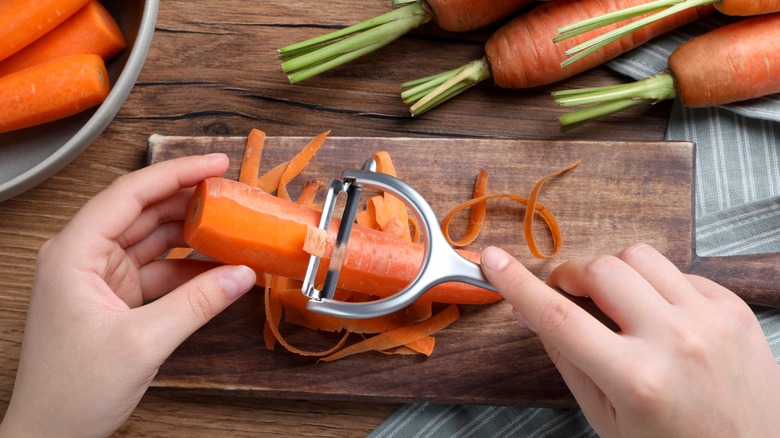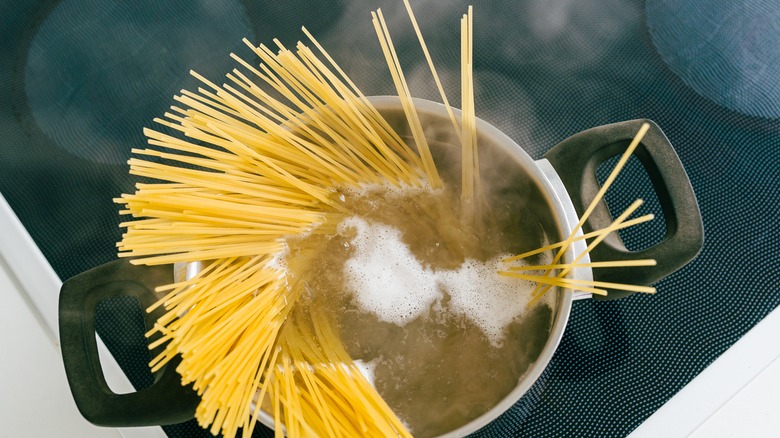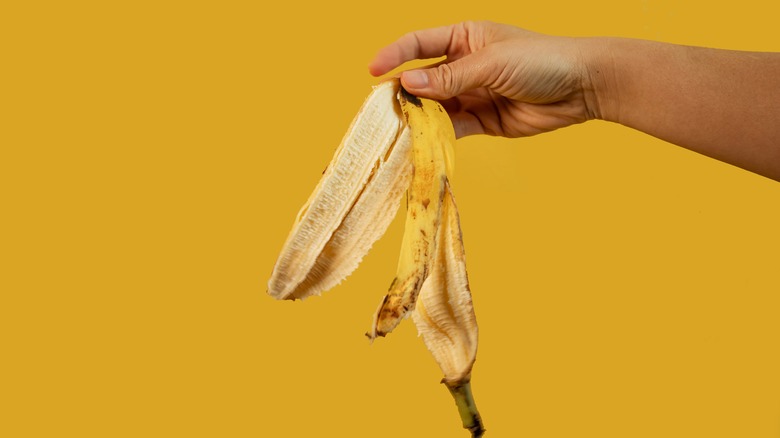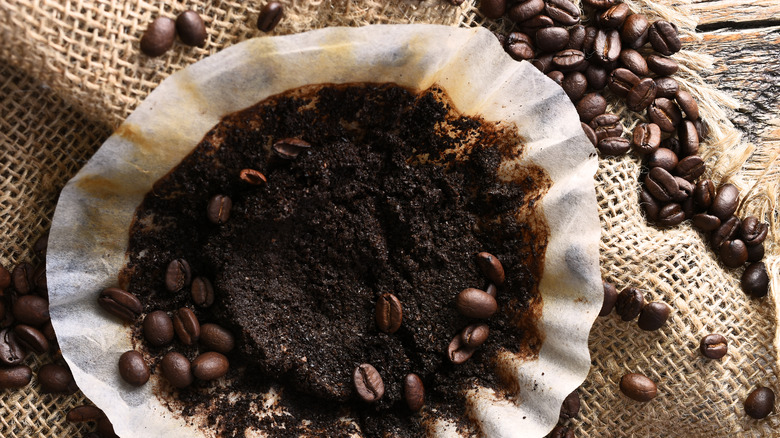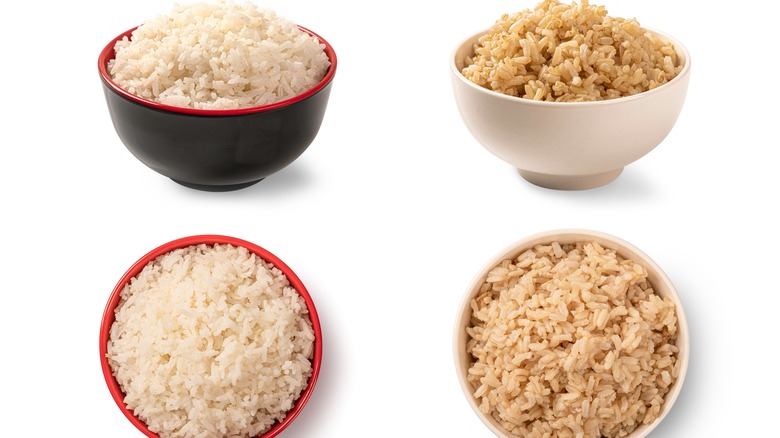12 Foods You Should Never Put Down The Drain
A garbage disposal is a powerhouse in the kitchen. It helps grind up all of your leftovers, saving individuals from meticulously clearing each plate before rinsing or washing it. Benjamin Franklin the Punctual Plumber explains that garbage disposals have several parts that all work together to separate, grind, and eventually dispose of food particles. When you put food items down the drain, they enter the hopper chamber of the disposal. Until you flip the switch to turn on the motor, the various items collect in the upper portion of the hopper. Then, once the unit is turned on, the flywheel spins quickly, pressing foods against the sharp indentations along the shredder ring, breaking the food down into tiny bits that can then be sent through the drainpipe and into the sewer line.
It's common knowledge that plastic and metal can damage a garbage disposal, but did you know that there are also several foods that you should avoid putting in your disposal in the kitchen sink? If the wrong items are sent down the drain, they could damage the garbage disposal or clog the pipes and cause the sink to back up.
1. Bones
Bones are one thing that you should never put down the drain or in the garbage disposal. According to Mitch Wright Plumbing, Heating & Air, bones are very dense. This means that they may cause the blades on the disposal to break, making it necessary to purchase a replacement. If the bones don't actually break the blades, they can make them duller and less effective for future needs. Keeping bones out of the drain is probably worth avoiding the expense to pay to have the blades sharpened or purchase a replacement unit. Simpson Plumbing adds that if large chunks of bone do make it through the disposal, they could even cause a clog, adding an additional headache.
Instead of putting bones down the drain, look into whether your local government offers a green waste program and accepts bones. The higher pressure and heat of this type of system will cause the bones to decompose much more quickly than they would in a home compost pile. Plus, it is more environmentally-friendly than simply tossing the bones in the trash can where they'll just contribute to already overfull landfills.
2. Potato Peels
Peeling potatoes over the sink is often the easiest and least messy option. However, if you choose to do that, you'll want to collect the peels for disposal rather than pushing them down the drain. Wiggly Wisdom shares that potato peels should never be put in a garbage disposal. Why? The blades on a garbage disposal can easily cut through and grind down the peels, but the real problem lies in how much starch potatoes have.
When the starch from the peels mixes with the water sent down the drain, it basically turns into glue. As this builds up in the disposal and around the blades, it can get in the way of the blades being able to do their job and grind up other foods. If blades aren't working effectively, they can allow larger chunks of potatoes or other foods through to the pipe, which can result in a clog. Gathering your potato peels out of the sink and putting them in a compost bin or trash can is certainly worth the time and effort to avoid these problems.
If you do clog your disposal with potato peels, Mr. Kitchen Faucets explains how baking soda and vinegar may be able to help dissolve the starch. Start by pouring ¼ cup of baking soda into the drain and letting the disposal run for about 10 seconds. Then, after about 15 minutes, pour one cup of vinegar down the drain. As the reaction forms, it will help break down the baking soda. Finally, you can pour a pot of boiling water down the drain after about 10 minutes to try to flush everything out.
3. Celery
Shiny Modern explains that celery should also never be put down the garbage disposal. Because of how fibrous celery is, it can cause damage to the blades. If you've ever eaten or peeled celery, you know that it can be very stringy. When the vegetable is put down the disposal, these long and thick strings end up wrapping around the blades. Sometimes, this could cause enough damage to the blades that the disposal will stop working. Other times, the fibrous celery pieces will continue to go through the disposal and into the drain pipes, where they can create a clog.
Instead of putting celery down the drain, the best choice is to put it in a compost bin. If you don't have your own backyard bin, look into whether your community or local government has a collection site where residents can drop off their items. If composting isn't possible, throwing celery in the trash is a better option than trying to put it through the garbage disposal.
4. Eggshells
You may have been told by your mother, grandmother, or another trusted individual that you should be putting your eggshells down the drain because they will help keep the disposal's blades sharp. Unfortunately, as Hometown Plumbing explains, this is a myth, and eggshells should not be put down the disposal. They note that when you put eggshells down the drain, you run the risk of clogging the pipes. This is due to the composition of an eggshell. The egg's membrane, located on the inside of the shell, is very stringy. When the egg goes down into the garbage disposal, the string membrane may become wrapped around the shredder ring, interfering with its ability to work.
Possibly even worse than this potential problem is the fact that the rest of the eggshell will basically be crumbled into something that resembles sand. When all these tiny pieces of eggshell are sent into the pipe, it could result in a clog. The risk of a clog increases even more when you put several eggshells down the drain, sending even more sand-like substance into the pipes. If there is a lot of grease in your pipes, the chance of a clog forming increases even more. Rather than peeling eggs over the sink, try peeling them over a compost bin or trash can. If you want to be able to rinse the eggs as you go, place a colander or strainer over the drain to catch the shells.
5. Oatmeal
You should also keep oatmeal — particularly uncooked oatmeal — out of your drain and garbage disposal. Think about how oatmeal changes as it is cooked. The raw oats expand quite a bit, making the cooked bowl of oatmeal much thicker and stickier than its raw counterpart. Unfortunately, raw oats won't only expand when cooked in hot water or milk. As Vending Business Machine Pro Service explains, they will also swell and grow, which means that they could expand as they go down the drain. You likely already see where this is going; the expanding oats could cause a clog in the pipe.
Cooked oatmeal may also pose a risk for garbage disposals. Its stickier consistency could interfere with the blades being able to move properly and do their job. Should you decide to risk it and want to use your garbage disposal to get rid of oatmeal, avoid dumping a large quantity down at the same time. Rather, keep the water running and just dump a small amount down at a time to give everything time to pass through the disposal and pipes before putting more down the drain.
6. Bread
Bread and crusts are also best disposed of with the compost or trash. Shiny Modern points out that a slice of bread can absorb a lot of water, which can make it expand. Like the expanding oats discussed above, when the bread expands, it makes it more likely for it to cause a clog. This is particularly true for untoasted bread and rolls. Crispier slices of toast may not absorb as much water as an untoasted slice and will also be easier for the disposal's blades to quickly break down.
To use your garbage disposal to get rid of bread, you'll want to make sure that each slice is broken down into smaller pieces. Smaller pieces are less likely to expand enough to cause a clog, but you should still take care to avoid putting too many smaller pieces down the drain at the same time. Rather than throwing bread down the drain, regardless of how large or small the pieces are, it is best to dispose of it in a different way. Consider feeding the bread to birds in your yard, putting it in a compost bin, or placing it in the trash can.
7. Fruit pits
Peaches, cherries, nectarines, and other fruits have very hard pits. While you can place pieces of the fruits themselves in the garbage disposal without issue, CW Service Pros explains that their pits should not be put down the drain. Just as bones are hard enough to dull, damage, or even break the blades, the same is true for pits. If they hit the blade in the right way, it may result in the garbage disposal completely turning off.
It is unlikely that you'll purposefully drop one of these hard pits down the drain, but more likely that one may accidentally slip beneath the disposal's cover when you're washing dishes. This can be even more likely with cherries or other smaller fruits that have relatively tiny pits. The Rooter Works recommends placing a drain guard over the disposal when you're washing dishes. The guard can help stop pits and other items that could damage the disposal from inadvertently entering it. Before turning on the disposal, you could also reach your hand down to feel around for fruit pits, silverware, or any other items that could wreak havoc on it.
8. Carrot peels
After peeling several carrots to make soup, carrot soufflé, or roasted vegetables, it can be tempting to just put them down the drain and turn on the disposal. However, according to Shiny Modern, doing so wouldn't be a very wise idea. Carrot peels are very long and skinny. They may make it through the blades of the disposal without getting ground down. If this happens, they can get stuck in various parts of the disposal system. In some cases, they can even travel through the disposal to your pipes, where they'll create a clog and cause the sink to back up.
While you shouldn't put carrot peels down the drain, a garbage disposal can typically handle uncooked whole or cut carrots just fine. Unlike celery and some other vegetables, carrots are not stringy. The blades should be able to ground them up well without causing any clogs or backups. Cooked carrots, on the other hand, should also not be put down the disposal. Their squishier texture can make it harder for the blades to adequately break them down, which can increase the chances of a clogged pipe.
9. Pasta
Pouring large quantities of pasta down the drain is another no-no. Home Cook World explains that semolina flour is one of the main ingredients in pasta. This flour is made up of gluten and starch. Learning about what happens to each of these components when the pasta is cooked can help you understand why you should keep it out of your drain. When the noodles are put in the boiling water, it causes the gluten protein to get harder. At the same time, the starches are soaking up the water. This makes them expand and creates the sticky texture that is associated with pasta. You can see some of the remnants of the starch in the pasta water that looks a bit thicker and gelatinous than the plain water you started with.
If you put pasta down the drain, the water can make it expand more, causing a blocked pipe. The long and sticky noodles may also wrap around and get in the way of the blades. If your drain does become clogged by pasta noodles, CleanCurious shares that you can add baking soda to the drain, followed by white vinegar. Just as this mixture can dissolve the starches of potato peels to clear a clog, it can also help with dissolving pasta starch. Keeping grease and cooking oil out of the drain can help prevent future clogs caused by pasta. The presence of grease can make the individual pieces of pasta stick to one another, creating a larger obstruction.
10. Banana peels
Like celery, banana peels are also fibrous. Wiggly Wisdom notes that putting them down the garbage disposal is not recommended. With their higher fiber levels, it can be challenging for the disposal to effectively break them down. Moreover, the stringy parts of the peel could also wrap themselves around the blades, causing them to jam or be less effective. If the garbage disposal is not able to effectively grind the peels down into tiny pieces, larger pieces could slip through into the pipes, causing a clog.
The ideal way to get rid of banana peels is by composting them. The compost you make can then be used to help your plants grow. Another option instead of tossing banana peels into the trash is to cut them and bury a few pieces in the upper layer of soil in the garden. The banana peels can actually help repel aphids and keep them from infesting your plants.
11. Coffee grounds
Home Grounds strongly advises against putting coffee grounds down the garbage disposal or drain. Consider what happens to the grounds when you brew a pot of coffee. What starts as a loose powdery substance ends up heavy and clumped together after the water goes through the grounds. This is the same thing that can happen if you put the coffee grounds down the drain: They can form a thick and heavy clump that can block the flow of water through your pipes. While it is best to completely avoid putting any coffee grounds down the drain, if you decide to give it a try, be sure to keep the water running while you're dumping the grounds. Then, let it run for a few more minutes after you've finished rinsing them down to help flush everything out.
Believe it or not, coffee grounds can actually be very beneficial to your garden. So, instead of dumping them down the drain or tossing them in the trash, consider sprinkling them around your plants. They'll help encourage earthworms to visit your plants and will also enrich the soil by adding potassium, nitrogen, and other nutrients.
12. Rice
DumpDisposal shares that boiled rice can be used in place of glue. The same gummy and sticky characteristics that make it a possible stand-in for glue are also the reason why you should not put rice down the drain or garbage disposal. The rice can get stuck to the impellers, clogging the disposal and creating a backup in your kitchen sink. In addition to being very sticky, rice also absorbs water and expands. Even if you just put a small amount of rice down the drain, as it absorbs more water, the clump may grow large enough to block your pipes.
If rice has clogged your garbage disposal, you may be able to clear the blockage without needing a plumber. Bring 2 ½ cups of water to a boil on the stove. Once boiling, carefully pour the water into the sink and let it sit for about 15 minutes. Then, turn the faucet on at full force and let warm water run through the disposal to the pipes to try to flush everything out. If the water from the sink doesn't fully drain out, you can try repeating the steps above. Alternatively, you can also try the method shared above to dissolve starches by pouring baking soda into the drain followed by a cup of white vinegar.
